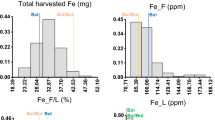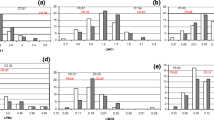Abstract
Key message
Rootstock HKT1 genotype affected fruit [Na + ] and non-commercial fruit yield; QTL analysis of rootstock-mediated scion nutrition is a powerful forward genetic approach to identify wild genes for rootstock breeding.
Abstract
The present study approaches the QTL dissection of rootstock effects on a commercial hybrid variety grafted on a population of RILs derived from Solanum pimpinellifolium, genotyped for 4370 segregating SNPs from the SolCAP tomato panel and grown under moderate salinity. Results are compared to those previously obtained under high salinity. The most likely functional candidate genes controlling the scion [Na+] were rootstock HKT1;1 and HKT1;2 as it was previously reported for non-grafted genotypes. The higher fruit [Na+] found when rootstock genotype was homozygote for SpHKT1 supports the thesis that scion HKT1 is loading Na+ into the phloem sap in leaves and unloading it in sink organs. A significant increment of small, mostly seedless, fruits was found associated with SlHKT1 homozygous rootstocks. Just grafting increased the incidence of blossom end rot and delayed fruit maturation but there were rootstock RILs that increased commercial fruit yield under moderate salinity. The heritability and number of QTLs involved were lower and different than those found under high salinity. Four large contributing (>17 %) rootstock QTLs, controlling the leaf concentrations of B, K, Mg and Mo were detected whose 2 Mbp physical intervals contained B, K, Mg and Mo transporter-coding genes, respectively. Since a minimum of 3 QTLs (two of them coincident with leaf K and Ca QTLs) were also found governing rootstock-mediated soluble-solids content of the fruit under moderate salinity, grafting desirable crop varieties on stress-tolerant rootstocks tenders an opportunity to increase both salt tolerance and quality.



Similar content being viewed by others
References
Almeida P, de Boer G-J, de Boer A-H (2014) Differences in shoot Na+ accumulation between two tomato species are due to differences in ion affinity of HKT1;2. J Plant Physiol 171:438–447
Aloni B, Kami L, Deveturero G, Levin Z, Cohen R, Kazir N, Lotan-Pompan M, Edelstein M, Aktas H, Turhan E, Joel DM, Horey C, Kapulnic Y (2008) Physiological and biochemical changes at the rootstock scion interface in graft combinations between Cucurbita rootstocks and a melon scion. J Hortic Sci Biotechnol 83:777–783
Ashrafi H, Kinkade MP, Merk HL, Foolad MR (2012) Identification of novel quantitative trait loci for increased lycopene content and other fruit quality traits in a tomato recombinant inbred line population. Mol Breed 30:549–567
Asins MJ, Breto MP, Carbonell EA (1993) Salt tolerance in Lycopersicon species. II. Genetic effects and search of associated traits. Theor Appl Genet 86:769–774
Asins MJ, Bolarín MC, Pérez-Alfocea F, Estañ MT, Martinez-Andújar C, Albacete A, Villalta I, Bernet GP, Dodd I, Carbonell EA (2010) Genetic analysis of physiological components of salt tolerance conferred by Solanum rootstocks. What is the rootstock doing for the scion? Theor Appl Genet 121:105–115
Asins MJ, Villalta I, Aly MM, Olías R, Álvarez De Morales P, Huertas R, Li J, Jaime-Pérez N, Haro R, Raga V, Carbonell EA, Belver A (2013) Two closely linked tomato HKT coding genes are positional candidates for the major tomato QTL involved in Na+/K+ homeostasis. Plant Cell Environ 36:1171–1191
Berthomieu P, Conejero G, Nublat A, Brackenbury WJ, Lambert C, Savio C, Uozumi N, Oiki S, Yamada K, Cellier F, Gosti F, Simonneau T, Essah PA, Tester M, Vèry A-A, Sentenac H, Casse F (2003) Functional analysis of AtHKT1 in Arabidopsis shows that Na+ recirculation by the phloem is crucial for salt tolerance. The EMBO J 22:2004–2014
Bittner F (2014) Molybdenum metabolism in plants and crosstalk to iron. Front Plant Sci 5:28. doi:10.3389/fpls.2014.00028
Bolarin MC, Fernandez FG, Cruz V, Cuartero J (1991) Salinity tolerance in 4 wild tomato species using vegetative yield salinity response curves. J Am Soc Hort Sci 116:286–290
Cuartero JM, Fernández-Muñoz R (1999) Tomato and salinity. Sci Hortic 78:83–125
Cuartero J, Yeo AR, Flowers TJ (1992) Selection of donors for salt-tolerance in tomato using physiological traits. New Phytol 121:63–69
Dorais M, Papadopoulos AP, Gosselin A (2001) Influence of electric conductivity management on greenhouse tomato yield and fruit quality. Agronomie 21:367–383
Estañ MT, Medina S, Morales B, Moyano E, Bolarín MC, Asins MJ (2008) Utilización como portainjertos de líneas RILs derivadas de S. lycopersicum x S. chesmaniae y S. lycopersicum x S. pimpinellifolium para mejorar el cultivo de tomate bajo condiciones salinas. In: Monreal LR, Ruiz JM, Blasco B, Rubio MM, Sánchez E, Ríos JJ, Cervilla LM (eds) Presente y Futuro de la Nutrición Mineral de Plantas, Héctor Santillán CP 18183, Granada, pp 225–235. ISBN: 978-84-89780-10-7
Estañ MT, Villalta I, Bolarín MC, Carbonell EA, Asins MJ (2009) Identification of fruit yield loci controlling the salt tolerance conferred by solanum rootstocks. Theor Appl Genet 118:305–312
FAO (2008) FAO land and plant nutrition management service. http://www.fao.org/ag/agl/agll/spush/
Farias EAD, Ferreira RLF, Neto SED, Costa FC, Nascimento DS (2013) Organic production of tomatoes in the Amazon Region by plants grafted on wild Solanum rootstocks. Cienc Agrotecnol 37:323–329
Fernandez-García N, Martinez V, Cerdá A, Carvajal M (2004) Fruit quality of grafted tomato plants grown under saline conditions. J Hortic Sci Biotech 79:995–1001
Foolad MR, Lin GY (1997) Genetic potential for salt tolerance during germination in Lycopersicon species. HortSci 32:296–300
Gilliam JW (1971) Rapid measurement of chlorine in plant materials. Soil Sci Soc Am Proc 35:512–513
Hasegawa S, Sogabe Y, Asano T, Nakagawa T, Nakamura H, Kodama H, Ohta H, Yamaguchi MK, Mueller MJ, Nishiuchi T (2011) Gene expression analysis of wounding-induced roots-to-shoot communication in Arabidopsis thaliana. Plant Cell Environ 34:705–716
Kacperska A (2004) Sensor types in signal transduction pathways in plant cells responding to abiotic stressors: do they depend on stress intensity? Physiol Plant 122:159–168
King SR, Davis AR, Zhang X, Crosby K (2010) Genetics, breeding and selection of rootstocks for Solanaceae and Cucurbitaceae. Scentia Horticulturae 127:106–111
Kromdijk J, Bertin N, Heuvelink E, Molenaar J, de Visser PHB, Marcelis LFM, Struik PC (2014) Crop management impacts the efficiency of quantitative trait loci (QTL) detection and use: case study of fruit loadxQTL interactions. J Exp Bot 65:11–22
Monforte AJ, Asins MJ, Carbonell EA (1997) Salt tolerance in Lycopersicon species. 5. Does genetic variability at quantitative trait loci affect their analysis? Theor Appl Genet 95:284–293
Munnik T, Meijer HJG (2001) Osmotic stress activates distinct lipid and MAPK signalling pathways in plants. FEBS Lett 498:72–178
Pascual L, Desplat N, Huang BE, Desgroux A, Bruguier L, Bouchet J-P, Le Q, Chauchard B, Verschave P, Causse M (2014) Potential of a tomato MAGIC population to decipher the genetic control of quantitative traits and detect causal variants in the resequencing era. Plant Biotechnol J. doi:10.1111/pbi.12282
Price AH (2006) Believe it or not, QTLs are accurate! Trends Plant Sci 11:213–216
Raga V, Bernet GP, Carbonell EA, Asins MJ (2014) Inheritance of rootstock effects and their association with salt-tolerance candidate genes in a progeny derived from ‘Volkamer’ lemon. J Am Soc Hort Sci 139:518–528
Rose JKC, Lee HH, Bennett AB (1997) Expression of a divergent expansin gene is fruit-specific and ripening-regulated. Proc Natl Acad Sci USA 94:5955–5960
Ruzicka K, Ljung K, Vanneste S, Podhorska R, Beeckman T, Friml J, Benkova E (2007) Ethylene regulates root growth through effects on auxin biosynthesis and transport–dependent auxin distribution. Plant Cell 19:2197–2212
Saliba-Colombani V, Causse M, Langlois D, Philouze J, Buret M (2001) Genetic analysis of organoleptic quality in fresh market tomato. 1. Mapping QTLs for physical and chemical traits. Theor Appl Genet 102:259–272
Sauvage C, Segura V, Bauchet G, Stevens R, Do PT, Nikoloski Z, Fernie A, Causse M (2014) Genome wide association in tomato reveals 44 candidate loci for fruit metabolic traits. Plant Physiol. doi:10.1104//pp.114.241521
Savvas D, Colla G, Rouphael Y, Scharz D (2010) Amelioration of heavy metal and nutrient stress in vegetables by grafting. Sci Hortic 127:156–161
Savvas D, Savva A, Ntatsi G, Ropokis A, Karapanos I, Krumbein A, Olympios C (2011) Effects of three commercial rootstocks on mineral nutrition, fruit yield, and quality of salinized tomato. J Plant Nutr Soil Sci 1:154–162
Scrase-Field AMG, Knight MR (2003) Calcium: just a chemical switch. Curr Opin Plant Biol 6:500–506
Sim S-C, Durstewitz G, Plieske J, Wieseke R, Ganal MW et al (2012) Development of a large SNP genotyping array and generation of high-density genetic maps in tomato. PLoS ONE 7(7):e40563. doi:10.1371/journal.pone.0040563
Simon EW (1978) The symptoms of calcium deficiency in plants. New Phytol 80:1–15
Steele NM, Mccann MC, Roberts K (1997) Pectin modification in cell walls of ripening tomatoes occurs in distinct domains. Plant Physiol 114:373–381
Sun K, Hunt K, Hauser BA (2004) Ovule abortion in Arabidopsis triggered by stress. Plant Physiol 135:2358–2367
The Tomato Genome Consortium (2012) The tomato genome sequence provides insights into fleshy fruit evolution. Nature 485:635–641
Turhan A, Ozmen N, Serbeci MS, Seniz V (2011) Effects of grafting on different rootstocks on tomato fruit yield and quality. Hortic Sci 38:42–1497
Van Ooijen JW (2006) JoinMap 4. Software for the calculation of genetic linkage maps in experimental populations. Kyazma BV, Wageningen, Netherlands
Van Ooijen JW (2009) MapQTL 6. Software for the mapping of quantitative trait loci in experimental populations of diploid species. Kyazma BV, Wageningen, Netherlands
Villalta I, Bernet GP, Carbonell EA, Asins MJ (2007) Comparative QTL analysis of salinity tolerance in terms of fruit yield using two Solanum populations of F7 lines. Theor Appl Genet 114:1001–1017
Wang H, Inukaia Y, Yamauchia A (2006) Root development and nutrient uptake. Crit Rev Plant Sci 25:279–301
Witcombe JR, Hollington PA, Howarth CJ, Reader S, Steele KA (2008) Breeding for abiotic stresses for sustainable agriculture. Phil Trans R Soc B 363:703–716
Acknowledgments
This work was supported in part by grants from the Spanish Government (AGL2008-00197/AGR, RTA2011-00132-C02) and the European Union (FP7-KBBE-2011-5), contract # 289365 (ROOTOPOWER). Authors thank UNIGENIA BIOSCIENCE SLU for the grafting labor, Dr. A.J. Monforte (IBMCP, Valencia, Spain) for comprehensive access to information on SolCAP SNPs, and Dr. G.P. Bernet (IBMCP, Valencia, Spain) for technical assistance.
Conflict of interest
The authors declare that they have no conflict of interest.
Ethical standard
The authors declare that the experiment complies with the current laws of Spain.
Author information
Authors and Affiliations
Corresponding author
Additional information
Communicated by Richard G.F. Visser.
Electronic supplementary material
Below is the link to the electronic supplementary material.
Rights and permissions
About this article
Cite this article
Asins, M.J., Raga, V., Roca, D. et al. Genetic dissection of tomato rootstock effects on scion traits under moderate salinity. Theor Appl Genet 128, 667–679 (2015). https://doi.org/10.1007/s00122-015-2462-8
Received:
Accepted:
Published:
Issue Date:
DOI: https://doi.org/10.1007/s00122-015-2462-8




